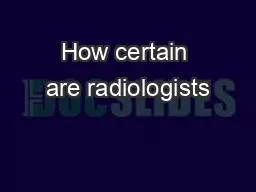

do we need a standardized lexicon for describing certainty in radiology reportsParasLakhaniBaskaranSundaramChristopher RothAdam FlandersThomas Jefferson University Philadelphia PAFinancial Disclosure ID: 891407
Download Pdf The PPT/PDF document "How certain are radiologists" is the property of its rightful owner. Permission is granted to download and print the materials on this web site for personal, non-commercial use only, and to display it on your personal computer provided you do not modify the materials and that you retain all copyright notices contained in the materials. By downloading content from our website, you accept the terms of this agreement.
1 How certain are radiologists - do we
How certain are radiologists - do we need a standardized lexicon for describing certainty in radiology reports? Paras Lakhani Baskaran Sundaram Christopher Roth Adam Flanders Thomas Jefferson University, Philadelphia, PA Financial Disclosures ⢠All Authors: Nothing to Disclose Pu
2 rpose ⢠The goal of this study is to
rpose ⢠The goal of this study is to assess the degree of certainty of commonly used terms in radiology reports among radiologists. Background ⢠Radiologists use a wide variety of terms to describe certainty in reports. ⢠Some examples include: â âSuspicious forâ â âSuggestive ofâ
3 â âMay representâ â âWorri
â âMay representâ â âWorrisome forâ â âCannot excludeâ Background ⢠Khorasani et al. surveyed radiologists and referring clinicians and found poor agreement in ranking 12 commonly used terms. 1 ⢠However, it is difficult to rank a high number (12 terms) and get consistency.
4 ⢠Standardization of terminology
⢠Standardization of terminology should improve consistency of reporting. 1. Khorasani R, Bates DW, Teeger S, Rothschild JM, Adams DF, Seltzer SE. Is terminology used effectively to convey diagnostic certainty in radiology reports?. Academic radiology. 2003 Jun 30;10(6):685 - 8. Background
5 ⢠Panicek et al. proposed a 5 poi
⢠Panicek et al. proposed a 5 point standardized scale for describing certainty. Term Estimated certainty (%) Consistent with �90% Suspicious for/probable ~75% Possible ~50% Less likely ~25% Unlikely Panicek DM, Hricak H
6 . How sure are you, doctor? A standardiz
. How sure are you, doctor? A standardized lexicon to describe the radiologist's level of certainty. American Journal of Roentgenology . 2016 Jul;207(1):2 - 3. Hypothesis ⢠When provided a 5 - point scale similar to that proposed by Panicek et al., radiologists are more consistent in assigning term
7 s to describe certainty. Methods â
s to describe certainty. Methods ⢠P erformed in a large teaching hospital. ⢠The authors identified 26 radiology terms to convey certainty ⢠Surveyed 107 radiologists (57 attendings , 10 fellows, and 40 residents ). ⢠Radiologists asked to categorize terms using a Likert scale:
8 â 5 ) Very high probability or diagnos
â 5 ) Very high probability or diagnostic of �(90 %) â 4 ) High probability (~75 %) â 3 ) Intermediate probability (~50 %) â 4 ) Low probability (~25 %) â 1) Very low probability (10%). ⢠Mean and standard deviation values were obtained. A two - tailed t - test was used for statisti
9 cal significance. Results ⢠S urve
cal significance. Results ⢠S urvey response rate was 54/107 ( 50.5%). ⢠Terms scored as indicating the highest �(90%) probability of certainty included: Term Score, SD_________ 1. " diagnostic of" ( 4.95 ± 0.21 ) 2. " represents" ( 4.88 ± 0.32 ) 3. " highly
10 suspiciousâ ( 4.81 ± 0.39 ) 4. "
suspiciousâ ( 4.81 ± 0.39 ) 4. " consistent with" ( 4.60 ± 0.66 ) 5. " in keeping with" ( 4.60 ± 0.62 ) 6. " highly suggestive" ( 4.58 ± 0.50 ) 7. " highly concerning" ( 4.53 ± 0.59 ) 8. " highly worrisome" ( 4.53 ± 0.55 ) 9. " most likely" ( 4.49 ± 0.55 ) 10. "compatible
11 with" ( 4.44 ± 0.67). Results â
with" ( 4.44 ± 0.67). Results ⢠Terms scored as indicating a high (~75%) probability of certainty included: Term Score, SD_________ 1. "suspiciousâ ( 3.84 ± 0.43 ) 2. "concerningâ ( 3.74 ± 0.54 ) 3. " probably" ( 3.70 ± 0.56 ) 4. " likely" ( 3.67 ± 0.52 )
12 5. "worrisomeâ ( 3.67 ± 0.57 )
5. "worrisomeâ ( 3.67 ± 0.57 ) 6. "suggestive " ( 3.65 ± 0.57 ) Results ⢠Terms scored as indicating an intermediate (~50%) probability of certainty included: Term Score, SD_________ 1. " may represent" (3.07 ± 0.46) 2. "could represent" ( 2.95 ± 0.43 ) 3. "
13 equivocal" ( 2.88 ± 0.50 ) 4. "
equivocal" ( 2.88 ± 0.50 ) 4. " possibly" ( 2.77 ± 0.61 ) 5. " maybe" ( 2.77 ± 0.48 ) 6. " question of" (2.70 ± 0.56) Results ⢠Terms scored as indicating a low (~25%) or very low (0%) probability of certainty included: Term Score, SD_________ 1. "unlikely"
14 ( 1.84 ± 0.37 ) 2. " not excluded"
( 1.84 ± 0.37 ) 2. " not excluded" ( 1.56 ± 0.74 ) 3. " inconsistent with" ( 1.33 ± 0.48 ) 4. "very unlikely" ( 1.00 ± 0.00). Results ⢠Statistical Significance: â The differences between the responses as grouped above were statistically significant (P) Conclusions ⢠W
15 hen provided a 5 point Likert scale,
hen provided a 5 point Likert scale, radiologists are fairly consistent in rating a wide variety of terms describing degree of certainty. ⢠This has implications for natural language processing systems, which can convert equivalent terms to those matching a standardized lexicon or rating system.